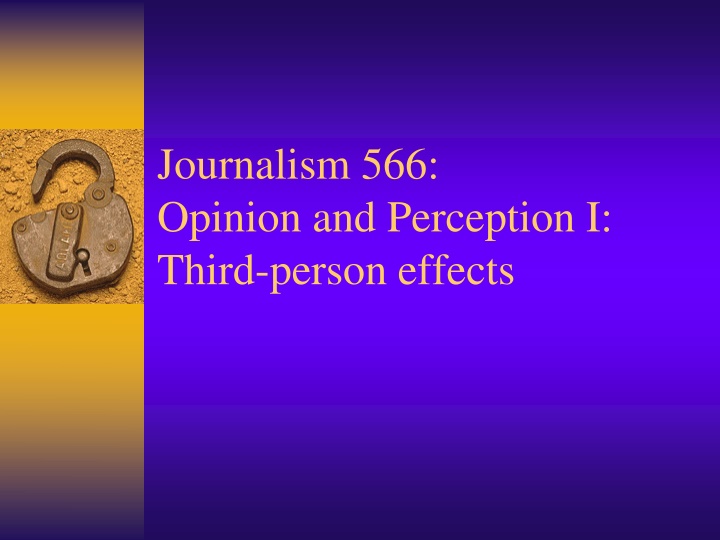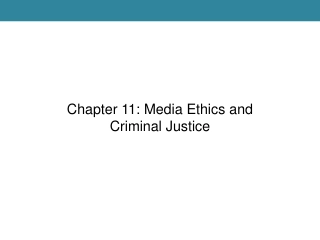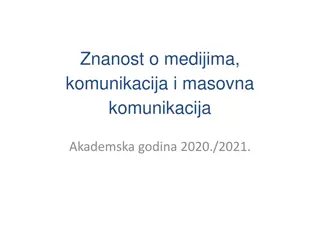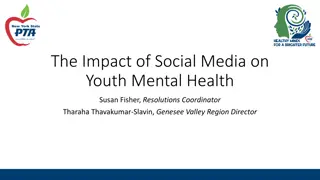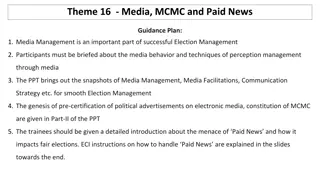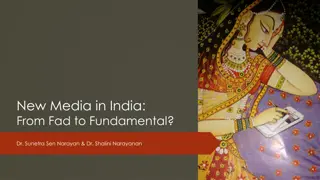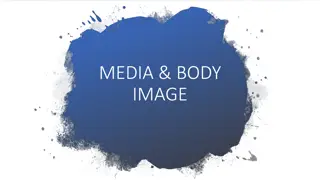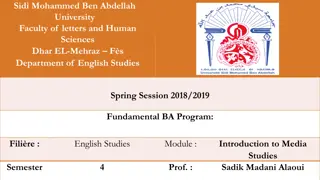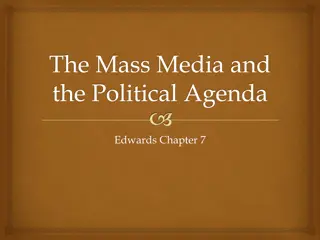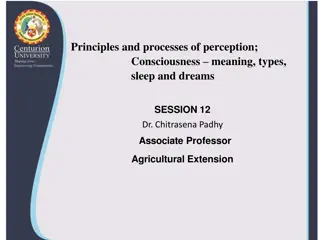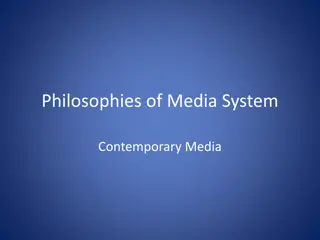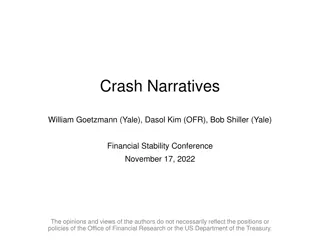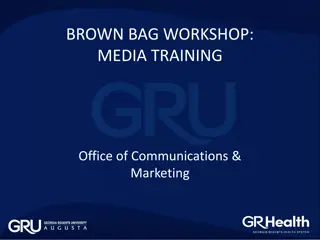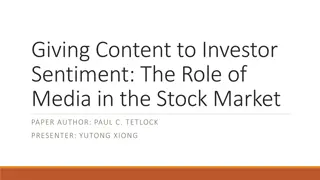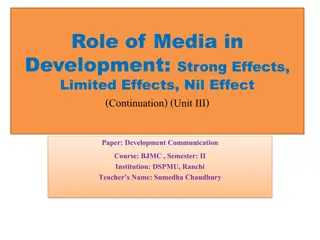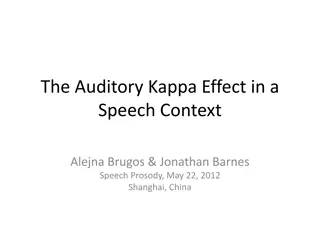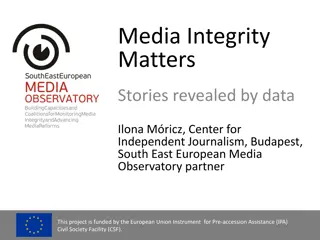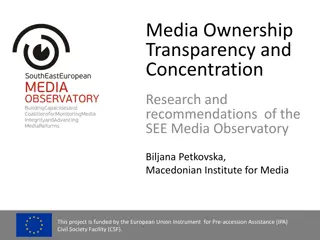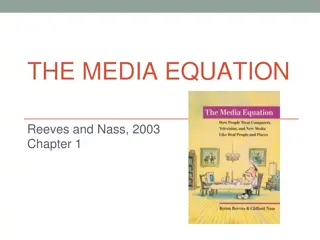Media Influence and Perception: Third-Person Effects
Concerns arise about media influence across various categories such as political advertising, pornography, and violent content. The Third-Person Effect (TPE) and Third-Person Perceptions (TPP) explore why individuals often believe that others are more affected by media messages than themselves. Research supports the existence of these effects, showing a tendency for people to perceive others as more influenced by negative media content. Understanding these concepts sheds light on how media can shape societal perceptions and behaviors.
Download Presentation

Please find below an Image/Link to download the presentation.
The content on the website is provided AS IS for your information and personal use only. It may not be sold, licensed, or shared on other websites without obtaining consent from the author.If you encounter any issues during the download, it is possible that the publisher has removed the file from their server.
You are allowed to download the files provided on this website for personal or commercial use, subject to the condition that they are used lawfully. All files are the property of their respective owners.
The content on the website is provided AS IS for your information and personal use only. It may not be sold, licensed, or shared on other websites without obtaining consent from the author.
E N D
Presentation Transcript
Journalism 566: Opinion and Perception I: Third-person effects
Concerns about the Media Various categories of media spark concern: Political Advertising Pornography Misogynistic Music/Videos Violent Television What else? What is the nature of the concern?
Basic Third Person Concepts The Third Person Perceptions (TPP or 3PP) Others more affected by media messages than I am A gap in perceptions between self and others Originally defined as Third person effect by Davison The Third Person Effect (TPE or 3PE) Cognitive and behavioral consequences of the TPP E.g., willingness to accept media censorship E.g., willingness to engage in corrective action First observed by Gunther (1995) and Rojas et al. (1996)
Theoretical Underpinnings Why do we see others as being more affected by media messages than ourselves? (McLeod et al., 2017) Negative bias Ego-enhancing motivational bias I am less affected by negative media messages I am not as easy to manipulate as others Pluralistic ignorance a general unawareness of what others really think and feel Social identity approach Us vs. them, the outgroup is more affected Social distance corollary The more dissimilar the others are, the more they are affected
Nature of Media Perceptions Perceive others will be more affected by negative media content than will oneself: Powerful Media: People tend to believe that media are persuasive and effects are common Hypodermic needle effect for others Persuasive press inference Personal Immunity: People also tend to feel immune to these effects Limited effects for self
Past Research on TPP Perloff reports that 15/16 studies reviewed found support for TPP for range of negative content: TV violence (Innes and Zeitz, 1988) Pornography (Gunther, 1995) Libelous news stories (Cohen et al., 1988; Gunther, 1991) Product advertisements (Thorson & Coyle, 1994; Shah et al. 1999) Negative political ads (Cohen & Davis, 1991) Holocaust-denial advertisements (Price et al., 1998) Media images of slimness (David & Johnson, 1998) Several other forms of potentially harmful media content
Past Research on TPP and TPE The Third Person Effect (TPE) Most common effect: desire for censorship Also on efforts to engage in corrective action Posting comments online to respond Results supporting the TPP: Gunther (1995): greater TPP associated with greater support for restrictions on pornography Rojas et al. (1996): TPE associated with desire to censor TV violence, pornography and general media content
Antecedents and Consequences Study 1: McLeod et al. (1997) Support for censorship of violent and misogynic rap lyrics: An analysis of the third-person effect Comm Research Study 2: McLeod et al. (2001) Behind the Third-person Effect: Differentiating Perceptual Processes for Self and Other Journal of Comm. Research Questions: TPP occur for violent and misogynistic music? Is there a connection between TPP and TPE? Who is seen as most affected by negative influence? What explains who perceives others as more affected?
Study 1: Results for TPE TPP predicts support for censorship (TPE) TPP predicts support for censorship TPP differential is the better predictor than the overall perceived negative effects
Antecedents of TPP Past research suggest several potential predictors of perceived effects: Perceived exposure to content Perceived common sense of content target Paternalism ( I know what s best ) Perceived anti-social nature of content
Study 2: Self and Other Perceptions Significant predictors for self: Common sense (reduces perceived effects) Anti-social lyrics (reduces perceived effects) Conditional effects model for self Internal factors mediate effects Significant predictors for others: Perceived exposure (increases perceived effects) Paternalism (increases perceived effects) Direct effects model for others Internal factors do not mediated effects
Consequences of TPE Censorship and other content restrictions Political behaviors Willingness to speak out Voting Self-protective behaviors Preventative behaviors against infectious diseases Body image behaviors Weight losing Online cosmetic surgery ads
The state of TPP & TPE New development: Anti-smoking ads (David, Liu, & Myser, 2004) Manipulative marketing techniques (Jung & Jo, 2013; Xie & Johnson, 2015) Journalistic of ethics (Lee & Coleman, 2020) Advertising s negative effects on body image (Chia, 2007, 2009) Infectious disease news and vaccination (Wei, Lo, and Lu, 2008) Fake news and regulation (Jang & Kim, 2018; Yang & Tian, 2021) Social media content moderation (Riedl, Whipple, and Wallace, 2021; Guo & Johnson, 2020) Sharing fact-checking messages (Koo et al., 2021) Climate change denial (Dalstrom & Rosenthal, 2018)
Big Questions About TPP & TPE Where do the perceptions come from? Is the judgment of effect on self based on an assumption about dosage or potency ? Ex. I am not affected because I do not see it Is the judgment of effect of other based on an estimate of a small effect on many people or a large effect on a few Ex. Porn may make sociopaths dangerous
Big Questions About TPP & TPE The nature of middle-range theory Agnostic to structural changes in media ecology From perceptions to behaviors Measurement: beyond self-report data The spin-off theory: Influence of the presumed influence Presumed effect on others (not the gap) -> behaviors Persuaded by our perceptions of others
Shift in Perspective Agenda setting, Framing, Priming, Cultivation, and Ads all have direct effects. Media content shapes opinion Ex. Frame of message shapes issue interpretation Third-person effects driven by perceptions of effects on self and others Media content spurs perceptions Ex. Perception of influences shapes censorship
Theories of Media Effects What theory best explains the relationship between media content and your opinion trend? What type of media content (ads, news, TV programs, popular music, etc.) affect your trend? Are there competing frameworks that explain the link between media content and your trend? Based on the framework(s), what predictions can you make about the relationship between specific media content and your opinion trend?
